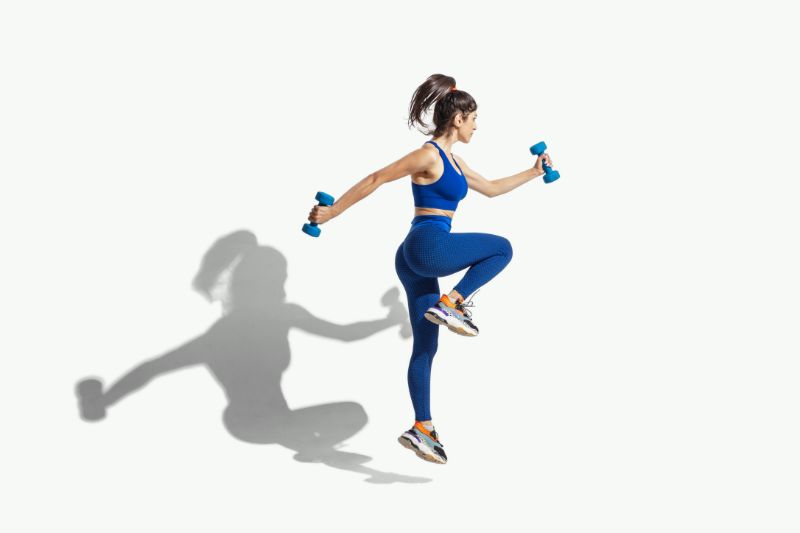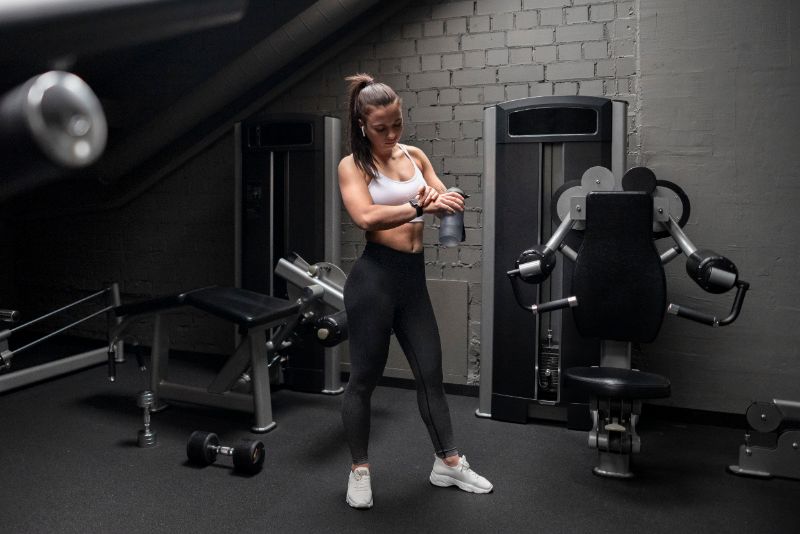When setting up a home gym, it is important to consider the types of equipment that will best meet your fitness needs while accommodating the space limitations of your home. Essential equipment can vary based on personal fitness goals, but certain items are commonly regarded as foundational for a versatile home workout setup.
Adjustable dumbbells are a practical choice as they offer a range of weights without requiring the space needed for multiple sets of fixed-weight dumbbells. This versatility makes them ideal for strength training exercises that target different muscle groups.
A yoga mat is another fundamental piece, useful not only for yoga but also for a variety of floor exercises and stretching routines. Its cushioning provides support and comfort, while its non-slip surface enhances safety during workouts.
For those looking to incorporate cardiovascular training, a compact cardio machine such as a stationary bike or a treadmill can be valuable. These machines are beneficial for improving cardiovascular health, burning calories, and can be used regardless of weather conditions.
Lastly, a resistance band set can be an excellent addition due to their flexibility and effectiveness in building strength, improving flexibility, and enhancing muscle tone. They are also lightweight and easy to store, making them an excellent option for those with limited space.
In summary, when selecting equipment for a home gym, it is essential to choose items that offer flexibility, functionality, and are appropriate for the available space. Adjustable dumbbells, a yoga mat, a cardio machine, and resistance bands are among the most versatile and space-efficient options that can help build a solid foundation for a home workout regimen.
Defining Your Workout Goals
Before investing in home exercise equipment, it’s important to define your fitness goals. Consider factors such as your current fitness level, the space you have available, your budget, and the types of workouts you prefer.
These factors will help determine the appropriate equipment for your home gym. For example, if your focus is on strength training, equipment like dumbbells may be necessary. Conversely, if your goal is to improve cardiovascular health, a treadmill might be more appropriate.
Choosing the Right Equipment
When selecting home exercise equipment, it’s important to consider your fitness objectives and the available space in your home. Equipment such as an adjustable weight bench and resistance bands can be beneficial due to their adaptability across various exercises, making them suitable for different fitness routines.
An adjustable weight bench is versatile for strength training exercises, while resistance bands offer flexibility and can be used for a range of workout intensities.
It is advisable to maintain a budget that allows for the purchase of high-quality, essential equipment. Investing in durable and versatile items can be more cost-effective in the long term.
When choosing equipment, thorough research into different brands and models is recommended to ensure that the products are reliable and offer the best value for your investment. This approach helps in acquiring equipment that not only meets your fitness needs but also fits well within your economic limits.
Space Considerations for Home Gym
When planning a home gym, it’s essential to accurately assess the available space which typically varies between 50 and 200 square feet. This area should accommodate both cardio and strength training equipment. To facilitate safe and effective workouts, maintaining clear pathways is necessary.
Opting for foldable or adjustable equipment can enhance the utilization of limited space, as these can be compacted and stored away when not in use. Implementing storage solutions such as wall mounts or racks will help keep the area tidy and maximize available floor space.
It is also important to select equipment that’s stable and robust, reducing the risk of accidents caused by tipping or shifting during exercise.
Carefully planning the layout and organization of a home gym can significantly improve its functionality and safety, contributing to a more productive exercise environment.
Strength Training Essentials
Once your workout area is prepared, it’s important to consider the appropriate equipment for strength training.
An adjustable bench is beneficial as it allows for a variety of exercises and helps in achieving a full range of motion.
A barbell, along with various weighted plates, is effective for targeting specific muscle groups.
Additionally, a pull-up bar is a useful tool for enhancing upper body strength.
Kettlebells are advantageous for conducting dynamic, full-body exercises and contribute to functional strength development.
Furthermore, a power rack is advisable for those looking to perform heavy lifts safely. It supports the weight during exercises and reduces the risk of injury.
Equipping your home with these items can facilitate a comprehensive strength training regimen.
Importance of Cardio Equipment
Cardio equipment, such as stationary bikes, plays a significant role in enhancing cardiovascular health and overall fitness. Including such equipment in a home gym allows for flexibility in scheduling workouts, which can be particularly convenient.
The variety of exercises available with cardio equipment can help maintain engagement and provide sufficient challenge to benefit physical health.
Regular use of cardio equipment can contribute to weight management, stress reduction, and improved heart health. Having easy access to such equipment at home eliminates the need to depend on gym availability or favorable weather conditions, potentially leading to more consistent exercise habits.
Yoga and Flexibility Tools
In constructing a comprehensive home gym, the inclusion of yoga and flexibility tools is beneficial for developing a balanced fitness routine. Yoga mats are fundamental, providing necessary cushioning for yoga poses and other stretching exercises, which helps in preventing injuries related to hard surfaces.
Yoga blocks are useful for supporting and aligning the body during various poses, aiding in the improvement of flexibility and helping practitioners of all levels achieve poses they mightn’t otherwise be able to maintain. Foam rollers can be implemented to facilitate myofascial release, which is the relaxation of tight muscle fibers and the reduction of muscular tension. This process can enhance overall flexibility and mobility.
Stretching bands are tools designed to assist in increasing a user’s range of motion. These bands provide resistance and are used in a variety of stretches and strengthening techniques. Balance balls, or stability balls, are another key component, primarily used to strengthen the core muscles, which are vital for overall stability and balance.
Investing in Quality Gym Flooring
Quality gym flooring is an important consideration for home workout spaces. The primary function of this flooring is to protect the underlying floors from damage that can occur due to the use of heavy exercise equipment. Additionally, gym flooring helps in reducing noise, which is particularly beneficial in residential settings.
A stable and safe surface is essential for preventing injuries during workouts. Quality gym flooring offers this stability and can help in absorbing impacts, which not only contributes to safety but also reduces wear and tear on exercise equipment, potentially extending its usable life.
There are various types of gym flooring available, such as rubber mats and interlocking tiles. Each type has its own set of benefits and can be selected based on specific workout requirements and personal preference. For instance, rubber mats are durable and offer significant noise reduction and shock absorption, while interlocking tiles provide versatility and ease of installation.
When selecting gym flooring, it’s important to consider factors such as the type of activities that will be performed in the space, the weight and type of equipment to be used, and the existing floor structure. This allows for an informed decision that enhances the functionality and safety of the home gym.
Safety Measures and Precautions
Prioritizing safety is essential when setting up a home gym to mitigate the risk of accidents and injuries. Utilizing exercise mats is an effective measure, as they provide both slip resistance and cushioning, which are critical for safety during physical activities.
Ensuring adequate ventilation in the gym area is another important factor, as it contributes to a well-lit and breathable environment, reducing the risk of overheating and providing sufficient air quality during exercise.
It is advisable to maintain sufficient space around all gym equipment. This space is necessary to prevent accidental contact that could lead to falls or other injuries. Additionally, understanding and applying proper form during exercises is crucial. Correct form not only enhances the effectiveness of the workout but also significantly reduces the risk of injuries related to improper technique.
Investing in high-quality, durable equipment is also recommended. Equipment that’s well-constructed tends to be more stable, thereby decreasing the likelihood of malfunctions and accidents.
Maintaining Your Home Gym Equipment
Maintaining your home gym equipment is essential for ensuring its longevity and functionality. Regular cleaning and maintenance are crucial, regardless of the complexity or cost of your setup.
For equipment such as weight benches, adjustable dumbbells, and indoor cycling bikes, it’s advisable to clean surfaces with a damp cloth to remove sweat and dirt, which helps maintain a hygienic workout environment.
It is also important to routinely check for and tighten any loose bolts or screws to ensure the structural integrity of the equipment. This step helps prevent potential accidents or equipment breakdowns.
Additionally, lubricating moving parts, particularly in machines such as treadmills, is necessary to facilitate smooth operation and prevent wear and tear.
Storing equipment in a dry, temperature-controlled environment is critical to avoid moisture-related damage and to preserve the materials used in the equipment. Proper storage conditions help prevent rust and degradation of components.
Adhering to these maintenance practices not only extends the lifespan of your home gym equipment but also supports the safety and effectiveness of your workout sessions.
Conclusion
When setting up a home gym, it’s essential to consider both strength training and cardiovascular equipment, complemented by yoga and flexibility tools. These elements cater to a comprehensive fitness regimen, promoting overall health and fitness.
Additionally, installing appropriate gym flooring is crucial as it enhances safety, reduces the risk of injury, and contributes to the durability of the exercise equipment.
Maintenance of the gym equipment is also key to ensuring its longevity and optimal performance. Regular checks and upkeep prevent equipment failure and ensure safety during workouts.
A well-planned home gym with the correct equipment can effectively support an individual’s fitness goals. It’s important to select equipment based on personal health objectives and available space.
By integrating various types of exercise equipment, individuals can create a balanced workout routine that addresses different aspects of physical fitness.
Related articles:
https://girlgains.co.uk/articles/how-to-do-fire-hydrant-exercise/


